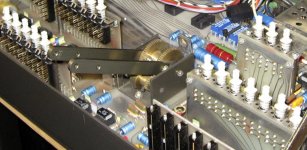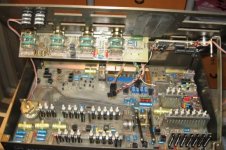no problem George, nothing I said was meant to reflect on you, other than perhaps missing the ancient date before linking it 😉 but I didnt see it either.
Sounds like Carver 🙂 BTW I was glancing at the FIFO thread, good stuff!
Carver used to come here for visits as he had a wife from here.
Very entertaining song and dance. But he did come up with some clever circuits. I liked using a light dimmer into a power transformer to reduce the core size required. The explanation for the magnetic field amplifier was magical!
Now a better example of old technology that still is extremely useful can be found here: http://www.repeater-builder.com/humor/signetics-wom.pdf
Demian
The analyzer is now $10,000! Pat has one and this is his answer attached.
ES
Not that I had $5K when it was the Miles time probe but that would have been a smart move.
The Morion oscillator is quite good. (Straight from St. Petersburg.) They are not real expensive. Your measurement stops at 1 KHz. Normally for Jitter for AES the range is something like 10 Khz to 100 Hz. Cutting off the low frequencies gets better numbers. Are your customers number freaks or just interested in verification?
Yes I suspected that was quite an old interview.The Meitner Interview is 20 years old! It's nice to know DIY has caught up.
I once complained to JA about the way that the Meitner box probed sensitive circuits, a rare letter to editor that got published (I leavened the criticism with plenty of praise).
no problem George, nothing I said was meant to reflect on you, other than perhaps missing the ancient date before linking it 😉 but I didnt see it either.
I never saw it as you reflecting on me. Don’t worry.🙂
I think the interview with Meitner is a fine example of Voodoo-electronics.
The only point I found a bit obscure, was on the reference of Bruel & Kjaer article. But he may be right there to. See the reference (very technical but SY and Scott may enjoy them)
http://www.bksv.com/doc/TechnicalReview1982-3.pdf
http://www.bksv.com/doc/TechnicalReview1982-4.pdf
see also addendum page 52 here
http://www.bksv.com/doc/TechnicalReview1983-1.pdf
George
Interesting concept in the first Tech Review article. Makes me think of the Poynting vector in electromagnetics.I never saw it as you reflecting on me. Don’t worry.🙂
The only point I found a bit obscure, was on the reference of Bruel & Kjaer article. But he may be right there to. See the reference (very technical but SY and Scott may enjoy them)
http://www.bksv.com/doc/TechnicalReview1982-3.pdf
http://www.bksv.com/doc/TechnicalReview1982-4.pdf
see also addendum page 52 here
http://www.bksv.com/doc/TechnicalReview1983-1.pdf
George
Not that I had $5K when it was the Miles time probe but that would have been a smart move.
The Morion oscillator is quite good. (Straight from St. Petersburg.) They are not real expensive. Your measurement stops at 1 KHz. Normally for Jitter for AES the range is something like 10 Khz to 100 Hz. Cutting off the low frequencies gets better numbers. Are your customers number freaks or just interested in verification?
They have no one who understands the numbers, so they go into the owners manual to make them happy. Do you really need to see -150db at 10K to know it has bottomed out?
Note you are looking at the oscillator it gets dived by 256 to become a word clock.
And just what do you expect for freebees?
Last edited:
in the late 1970's, when a French audio company put forth a preamp with a fancy name, a control stick, like on a plane, for a volume control, AND when you looked inside, you found only very dated IC's and cheap parts.
Commercial airplane thrust levers.

In those days, Elipson stuck a ball loudspeaker on a pole.
Nowadays, the same company hangs them on threads from the ceiling.
Attachments
Commercial airplane thrust levers.
In those days, Elipson stuck a ball loudspeaker on a pole.
Nowadays, the same company hangs them on threads from the ceiling.
Jacco,
I suspect you know how much nice brass gears like those cost in small quantities. Shame they used straight cut ones.
Pavel,
You are a founding member of the club. 🙂
George.
The Bruel and Kjaer sound intensity probes were a big deal when first introduced and are a great tool for acoustical speech intelligibility problems among other uses.
ES
Last edited:
They have no one who understands the numbers, so they go into the owners manual to make them happy. Do you really need to see -150db at 10K to know it has bottomed out?
Note you are looking at the oscillator it gets dived by 256 to become a word clock.
And just what do you expect for freebees?
The unfortunate part is that it then gets multiplied back up to be useful. The Time Probe is a great tool and your freebee was worth well more than you paid. That chart will end any quibbilng about specs. A rational calculation (10 Hz to 100 KHz gives you great bragging rights- 200 fS rms Jitter. Your divider will probably add that much. And its absolutely will not be a limitation with any known ADC or DAC. And you did it without space shuttle tiles. Femtosecond Galaxy Clock
Ok, I say goodbye to all the talented members of this thread, they will recognize themselves. I took great pleasure to share with you, learned interesting things, and appreciated your friendly community.
There are things I wish above all, technical relevance, equity, and freedom of expression are included.
There are things I wish above all, technical relevance, equity, and freedom of expression are included.
I see MSB has not suffered unduly from excessive humility 😀The unfortunate part is that it then gets multiplied back up to be useful. The Time Probe is a great tool and your freebee was worth well more than you paid. That chart will end any quibbilng about specs. A rational calculation (10 Hz to 100 KHz gives you great bragging rights- 200 fS rms Jitter. Your divider will probably add that much. And its absolutely will not be a limitation with any known ADC or DAC. And you did it without space shuttle tiles. Femtosecond Galaxy Clock
As a late friend used to say, Au reservoir, Christophe.Ok, I say goodbye to all the talented members of this thread, they will recognize themselves. I took great pleasure to share with you, learned interesting things, and appreciated your friendly community.
There are things I wish above all, technical relevance, equity, and freedom of expression are included.
I see MSB has not suffered unduly from excessive humility 😀
I see the guy worked on the ill fated CED at RCA.
brass
Mr Simon,
if you look at the rest of the picture, the case construction and parts show that it was sooner ahead of it's time.
On the other hand, at 8 French Francs to the Dollar then, it was a lot of money.
The orchestrator of the flight console is a colorful person in the yacht world.
Whether visionary or opportunist is a personal choice, but the gent is an innovator and does have commercial talent.
Somewhat of a playboy, born with money, usual background story.
Not entirely French by origin, his father was an Egyptian who made a bundle selling American cars, died when the pilot apprentice was four years old. At 35, the navigator grossed $150 million a year, as a Japanese gear importer.
(I saw and heard the item around the time of release, still have the brochure somewhere. can even tell you the first name of the bloke's mother, how sad can one be)
Jean-Christophe doesn't sound like a happy camper.
Last edited:
Agree. But sometimes one simply needs a break. The downside is you come back to ten thousand more posts to read.Christophe, please man up and stay on board. Like others I enjoyed your contributions.
I see the guy worked on the ill fated CED at RCA.
I had to search for that. 600 million. Ouch.
Capacitance Electronic Disc - Wikipedia, the free encyclopedia
EDIT: And that's when 600 million was a lot of money 😀
- Status
- Not open for further replies.
- Home
- Member Areas
- The Lounge
- John Curl's Blowtorch preamplifier part II

